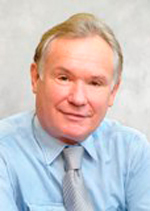David N. Payne: Difference between revisions
(Created page with "== Biography == During his four-decade career at the U.K.’s University of Southampton, David Payne has designed some of the highest power fiber lasers in the world and genera...") |
m (Text replace - "[[Category:Optical fiber applications" to "[[Category:Optics") |
||
| (4 intermediate revisions by 2 users not shown) | |||
| Line 1: | Line 1: | ||
== Biography == | == Biography == | ||
[[Image:Payne David.jpg|thumb|right]] | |||
During his four-decade career at the U.K.’s University of Southampton, David Payne has designed some of the highest power [[Fiber Optics|fiber lasers]] in the world and generated a host of fiber components in the telecoms and sensor arenas. He pioneered several key related developments, including photonics-based technologies for telecommunications, optical sensors, nanophotonics and optical materials. He also led the teams that invented the silica single-mode fiber laser and amplifier and broke the kilowatt barrier for high power fibre laser output. He was the first to use phosphorous as a core dopant to achieve numerous processing advantages and developed the erbium-doped fiber amplifier, which created a revolution in optical-fiber communications. | |||
[[Category: | A Fellow of the Royal Society, the Royal Academy of Engineering, [[The IEE|the IEE]], and the Optical Society of America, he is currently director of the University of Southampton’s Optoelectronics Research Centre. | ||
[[Category: | |||
[[Category:Photonics]] | [[Category:Optical fiber communication|Payne]] [[Category:Optics|Payne]] [[Category:Photonics|Payne]] | ||
Revision as of 16:55, 19 May 2014
Biography
During his four-decade career at the U.K.’s University of Southampton, David Payne has designed some of the highest power fiber lasers in the world and generated a host of fiber components in the telecoms and sensor arenas. He pioneered several key related developments, including photonics-based technologies for telecommunications, optical sensors, nanophotonics and optical materials. He also led the teams that invented the silica single-mode fiber laser and amplifier and broke the kilowatt barrier for high power fibre laser output. He was the first to use phosphorous as a core dopant to achieve numerous processing advantages and developed the erbium-doped fiber amplifier, which created a revolution in optical-fiber communications.
A Fellow of the Royal Society, the Royal Academy of Engineering, the IEE, and the Optical Society of America, he is currently director of the University of Southampton’s Optoelectronics Research Centre.
